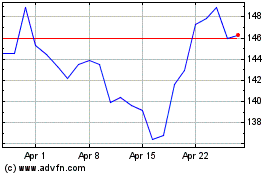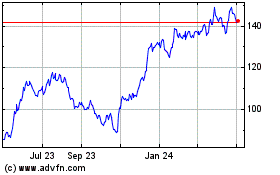By Orla McCaffrey
Banks are paying a pittance on deposits, but customers don't
seem to care.
Some banks are slashing deposit rates. Others are keeping
already-low rates at next to nothing, sometimes 0.01%. But
customers keep stashing cash at banks anyway.
Big banks can afford to be stingy because they already are awash
in deposits. Total deposits at U.S. commercial banks have swelled
to about $15.9 trillion, up from about $13.2 trillion at the start
of the year, according to the Federal Reserve.
The biggest banks, such as JPMorgan Chase & Co. and Bank of
America Corp., generally keep their rates low no matter what is
happening in the rest of the economy. They already have mountains
of deposits, as well as loyal customers who bank with them not for
high deposit rates but for ubiquitous branches, flashy apps or
because their paychecks and bills are already tied to their
accounts there.
Online-focused firms including Ally Financial Inc. and Goldman
Sachs Group Inc.'s Marcus, on the other hand, have touted their
high rates over the past few years as a way to attract deposits.
But even those banks are now cutting rates. Ally, Marcus and
Capital One Financial Corp., for example, have dropped their
deposit rates from about 1.6% to around 0.5% over the past eight
months.
Banks typically cut deposit rates when the Fed lowers short-term
interest rates. The Fed slashed rates dramatically in March,
trimming 1.5 points from its benchmark rate during two back-to-back
cuts. The online-focused banks have been cutting ever since.
Some brinkmanship is involved. Banks choose when to raise or cut
their deposit rates, but they are influenced by the Fed and by each
other. When the Fed lowers rates, banks -- especially the online
players -- generally want to reduce their rates too, but nobody
wants to be first for fear of turning off customers.
Big banks also have more deposits than they know what to do with
-- a more consistent catalyst for deposit-rate cuts this year,
analysts said.
Deposits began flooding into commercial banks in the spring,
when the economy shut down to battle the coronavirus pandemic. Loan
demand at many banks stalled at the same time, meaning banks have
fewer and less lucrative opportunities for putting their deposits
to work.
The spring surge was driven primarily by bank customers with
balances under $2,500, according to Novantas, a financial-services
research firm. They increased their total deposits by 66% from
mid-April to late May, compared with just 1% for higher-tier
customers, or those with deposits of at least $5,000.
Many lower-balance customers had more cash on hand after the
government rolled out coronavirus relief including expanded
unemployment benefits and one-time stimulus checks.
That began to change in early June, when higher-balance
customers began depositing at higher volumes. Higher-tier customers
have increased their balances by an average 8% over the past five
months, compared with just 2% for those with lower balances.
There are signs that the sea of deposits is, if not shrinking,
at least stabilizing. The overall rate of deposit growth has
flattened since its spring peak, though deposits remain at record
levels.
The level of reserves kept by lenders at their regional Fed
banks has ballooned alongside bank deposits. Banks stash deposits
at the Fed when they have more than enough to fund operations
including lending.
Regions Financial Corp. had more than $10 billion parked at the
Fed in the third quarter, up from its typical $1 billion to $2
billion, Chief Financial Officer David Turner said.
"Deposit growth has been off the chart but there's not a lot of
loan demand out there," he added.
Already-low deposit rates at bricks-and-mortar banks have
trended downward along with those at online banks. The average rate
on savings accounts at U.S. banks stands at 0.08%, down from 0.1%
in early spring, according to Bankrate.com, a personal-finance
website.
"Banks are trying to get rid of deposits," said Gary Zimmerman,
founder of MaxMyInterest, which matches bank customers with
higher-yield accounts. "The only way they know how to do that is
lowering rates and hoping people go away."
But for many people, money stashed in a savings account
represents an important protection against potential financial
hardship. Easy access to that money outweighs the fact that they
are being paid peanuts in interest.
Andrew Frisbie, executive vice president for consumer pricing at
Novantas, said the pandemic had made many customers more interested
in saving money for an emergency.
"The pandemic was the ultimate rainy day," he said.
Some customers, though, are the exception: They are happy to go
to the trouble of moving their money in search of higher
returns.
Ray Gustavis, a trial attorney in Jackson, Miss., decided to
move about $7,500 from Ally in July, when the bank cut its rate
from 1.10% to 1%.
Ally said it is "committed to providing tools that help people
make smarter money decisions -- no matter what the
environment."
Still, Ms. Gustavis decided to split the money in her Ally
account between the stock market and an account at another bank
that offered a slightly higher rate.
"It just made no sense to keep my money there anymore," Ms.
Gustavis said. "It might as well be put under my bed."
Write to Orla McCaffrey at orla.mccaffrey@wsj.com
(END) Dow Jones Newswires
November 12, 2020 05:44 ET (10:44 GMT)
Copyright (c) 2020 Dow Jones & Company, Inc.
Capital One Financial (NYSE:COF)
Historical Stock Chart
From Mar 2024 to Apr 2024

Capital One Financial (NYSE:COF)
Historical Stock Chart
From Apr 2023 to Apr 2024
